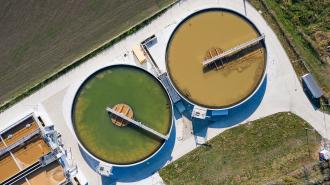A process for making wastewater drinkable again is now revealing hidden benefits. The discovery comes thanks to Stanford engineers, who’ve developed a cost-effective way to convert a toxic byproduct of the process into useful chemicals.
“Hopefully, this study will help accelerate adoption of technology that mitigates pollution, recovers valuable resources, and creates potable water all at the same time,” lead author Xiaohan Shao said in a press release.
The challenge: Wastewater (“sewage”) is freshwater that has already been used for cleaning, drinking, flushing, or other activities. It contains everything from human waste to industrial chemicals, so before returning it to the environment, we have to clean it at a treatment facility.
“We can make the gap between wastewater and drinking water smaller.”
Xiaohan Shao
It is actually possible to purify wastewater enough to make it drinkable again, and one of the most energy-efficient ways to do that is through anaerobic filtration, a process in which bacteria and other microorganisms break down and eat pollutants in the water.
The downside to anaerobic filtration is that it produces sulfide, which is a toxic and corrosive compound — simply breathing it in can harm workers at a wastewater treatment plant. The processes for dealing with sulfide, meanwhile, make disinfecting water more difficult.
The idea: A possible solution to this problem is to convert the sulfide into chemicals that can be used to create fertilizers and manufacture batteries, but no one has figured out the best way to do that.
Stanford engineers have now studied the conversion process and used what they learned to develop a cost-effective, low-energy method for creating the useful chemicals from sulfide.
“We can integrate our process into other advanced wastewater treatment technologies to [make] the gap between wastewater and drinking water smaller,” Shao said.
“And in terms of the chemicals we produce, we are adding these recovered products to the supply chain,” she continued. “It’ll help with agriculture, and in manufacturing, you’ll [reduce] raw material consumption.”
The big picture: It’s too soon to say whether Stanford’s process will actually be integrated into any treatment facilities, but anaerobic filtration — and the nasty sulfide it produces — isn’t the only way to make wastewater drinkable.
Alternatives that rely on other types of filtration might not be as energy-efficient, but in places where freshwater is scarce and energy is cheap, the expense of importing water can still make recycling and filtration the most cost effective way to boost the supply of drinking water.
We’d love to hear from you! If you have a comment about this article or if you have a tip for a future Freethink story, please email us at tips@freethink.com.
